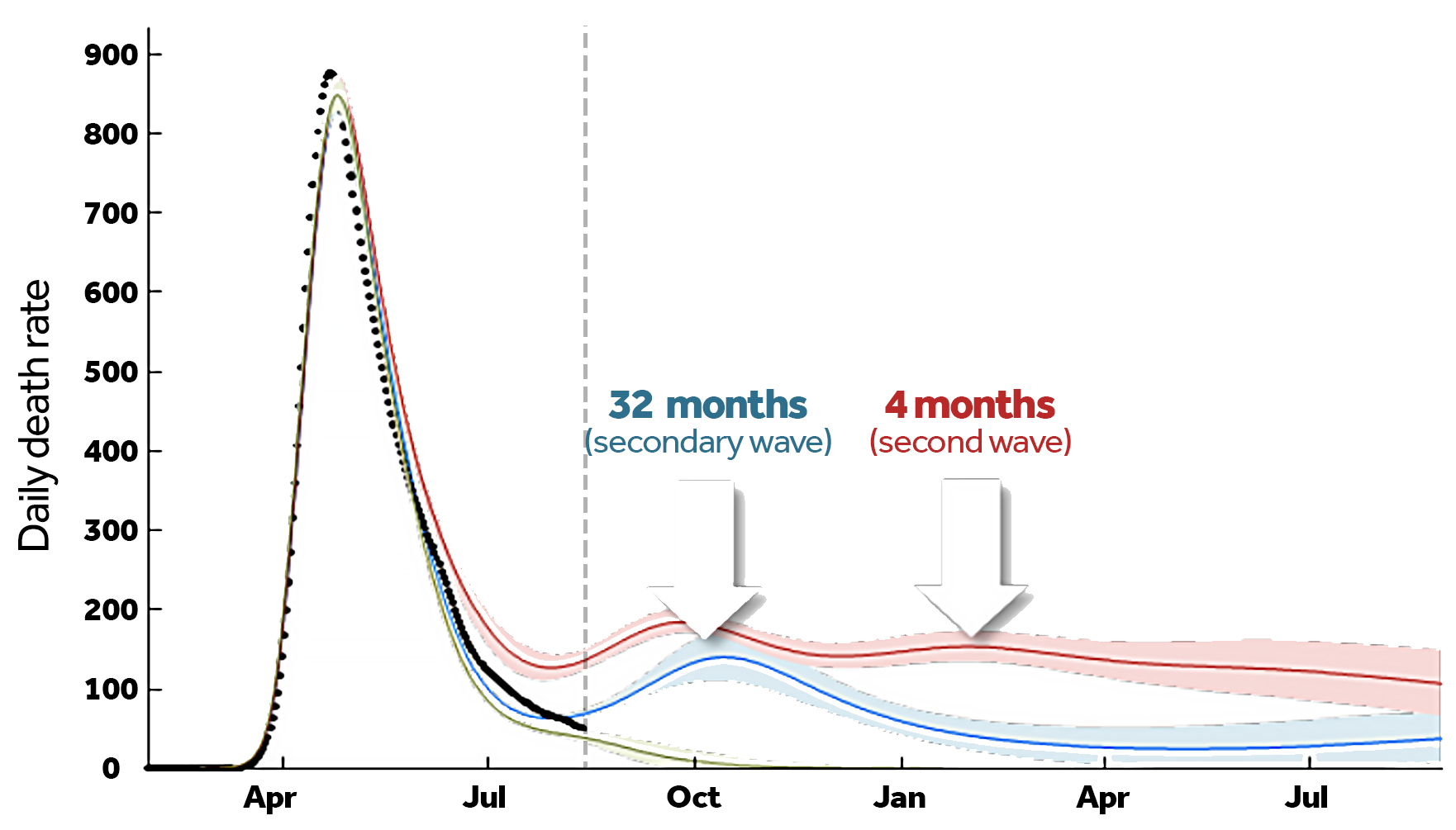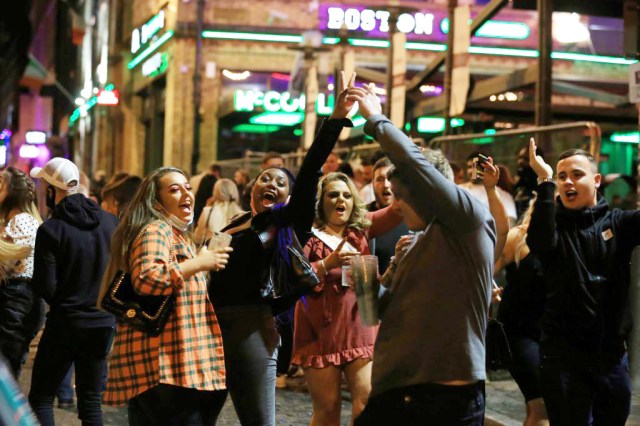Last night in Liverpool before the long winter. Photo by LINDSEY PARNABY/AFP via Getty Images

In the highly polarised debate over lockdowns, Professor Karl Friston is somewhat hard to place. He’s a member of “Independent SAGE”, a group of scientists set up to critique the Government advice which has been accused of being stocked with Left-wing activists, and he’s a signatory of the new “John Snow Memorandum” opposing the ideas around herd immunity of the Great Barrington scientists. So far, so orthodox. On the other hand, his concept of immunological “dark matter”, which he floated earlier in the summer, sent his scientific stablemates into paroxysms as it seemed to suggest that not everyone was equally susceptible to the virus — one of many concepts that seemed heretical at the time but is now uncontroversial.
His expertise is complex mathematical modelling of biological processes — he calls it “dynamic causal modelling” — which gained him global renown when applied to neuroscience and which he is now applying to the pandemic. Many people will be sceptical of the whole discipline of using maths to forecast the progress of the virus, since the controversial Neil Ferguson models and the disastrously poor IHME forecasts in the US. But Friston’s models, as well as being much more sophisticated, are different in the crucial respect of including societal and governmental effects as well as epidemiological factors; if deaths go up sharply, people start taking greater care, for example.
His models are starting to develop a track record. Back in early July, Friston appeared on Newsnight in a barely-noticed interview, and was asked if there would be a second wave. At the time, cases and deaths were falling and many people were hoping the virus was behind us altogether. “Yes, there will be [a second wave],” he told Kirsty Wark. “It’s not going to be the kind of second wave we saw in the Spanish Flu… this is going to be a much more muted second wave.” He predicted less than 6,800 deaths from it.
According to Professor Friston, the “secondary wave” is unfolding largely as predicted — see the blue line below, taken from his report in June (the 32 months refers to the typical length of time he is assuming immunity lasts). If we proceed as we are, without national lockdowns, the model suggests that daily deaths will soon peak and start coming down. He now thinks the total deaths from this second wave will be closer to 2,500 than 6,800.
Figure 1: June projection for a second wave (Karl Friston)

Friston was recently asked by the Independent SAGE group to model the effect of a two-week national “circuit breaker” lockdown, and the results (seen by UnHerd but not yet published anywhere) he found “slightly counterintuitive”.
The first finding is that a two-week national lockdown does not, as he had hoped, bring transmission right back down to zero. “I had thought that a national circuit break would ‘crush’ the curve,” he tells me. “However, I was wrong: although the secondary peak is suppressed, it leaves us with a chronic fatality rate that is slightly higher than the summer.”
In this respect, his findings could be taken as an argument against such a circuit-breaker, with all the disruption and damage it could cause. “The modelling suggests that the window of opportunity for suppression has now passed,” he says. He concludes that the effect of a circuit breaker, in the absence of new factors such as a much more effective test and trace system, would not be to reduce the total deaths in the long term, only delay them. At some point in the future, the total deaths for the two scenarios (with and without a circuit breaker) will converge.
The only game-changer, as far as Professor Friston is concerned, would be really effective contact-tracing and supported isolation; in his view, this is the only solid argument for a national circuit-breaker and is why he is happy for his name to be among the Independent SAGE voices calling for it. It would theoretically create the low-incidence environment in which such a system could start to work much better. (Of course, in order to take this gamble, you would have to assume that Her Majesty’s Government have the competence to seize that opportunity.)
When Professor Friston modelled the longer term death forecasts with — and without — a two-week national circuit breaker, the difference was stunning. The blue line shows deaths without a circuit-breaker to the end of 2022 and the green line shows it with a circuit breaker and improved contact tracing:
Figure 2: Death rate

According to Friston, the circuit break would have the effect of stopping the second wave in its tracks and interrupting the cycle of tertiary waves, fast-forwarding us into a state akin to what epidemiologists call “endemic equilibrium” — ie when a virus continues to circulate but at a manageable, more consistent level.
The difference seems so dramatic as to be, at first glance, too good to be true. One clear shortcoming is that the model doesn’t account for normal seasonal variations in the virus. But the underlying principle is that, once the epidemic has assumed the dynamic of a wave as Covid-19 now has, with cases always going up or down, it is like a pendulum and requires interruption to break the pattern. “Perhaps a good heuristic to get one’s head around the effect of a circuit break is to think about pushing a child on a swing. Now, you want to go home and stop the swing. You will almost certainly apply a short sharp force against the direction of travel when the speed is greatest – i.e., now, when cases are accelerating,” Friston says. In dynamic systems theory, this would be described as “amplitude death” — the destruction of oscillatory dynamics with a small, well-timed change to the parameters.
So what, I ask, would a two-week lockdown need to consist of to have this effect? “It only presumes we can replicate for two weeks the levels of reduced contact that we achieved in the spring,” he says. Seems achievable enough, but what happens after the two weeks? How quickly could we resume something more like normal life? “The forecasts imply an immediate rebound from lockdown that slowly recovers to levels that are about 70-80% of pre-covid contact rates, over the next few months, and then slowly recovers over years.”
And what presumptions does the model make about immunity? If only a small minority of people have immunity to the disease, and we gradually return to normal, wouldn’t the virus start to gather pace again among the majority of people who are still susceptible?
Friston’s model presumes that 33% of the population has been exposed to the virus. From the data, he has made inferences about immunity. “Of those that have been exposed, 82% appeared to be susceptible to infection; however, 40% of these may never produce antibodies. This means that if you split effective population immunity into seropositive and seronegative proportions [ie with and without antibodies], we should have about 8% seropositive immunity and about 23% seronegative immunity (presumably mediated by T-cell immunity). In total, this means over 30% of the population could be effectively immune.”
Professor Friston’s calculations take the wind right from the sails of both sides of this debate. According to him, the second wave is not going to be as bad as the spring, despite the claims of Deputy Chief Medical Officer Jonathan Van Tam that we are back where we were in April; Friston found Sir Chris Whitty’s simplistic projections of exponential growth “unnecessarily alarmist and unsupported by quantitative modelling”.
He suggests that we are dealing with a far more moderate resurgence, which you could argue does not warrant national interventions of this kind, with all the side effects they entail. As he said to me, “to put things in perspective, the number of lives saved from SARS-CoV-2 [from a national lockdown] is about twice the number of people dying from road traffic accidents in a year — and less than half the number dying from seasonal influenza.”
But, on the other hand, no one can look at that chart and not be intrigued to see if in two weeks we could achieve such a fundamental change in the dynamics. “These damped oscillations appear to be converted into a slow drift to endemic equilibrium (of a sort) — much like cardioversion, where a fast irregular heartbeat is returned to a slow rhythm following an electrical ‘reset’”.
Is it worth attempting? If the Professor is right (and it’s a big if), faced with such long-term devastation to the economy and society, even lockdown-sceptics might be tempted to accept the hit of a bounded two-week lockdown if it were to lead to a more constant low level that would actually, finally, allow life to gradually return to normal.










Join the discussion
Join like minded readers that support our journalism by becoming a paid subscriber
To join the discussion in the comments, become a paid subscriber.
Join like minded readers that support our journalism, read unlimited articles and enjoy other subscriber-only benefits.
Subscribe